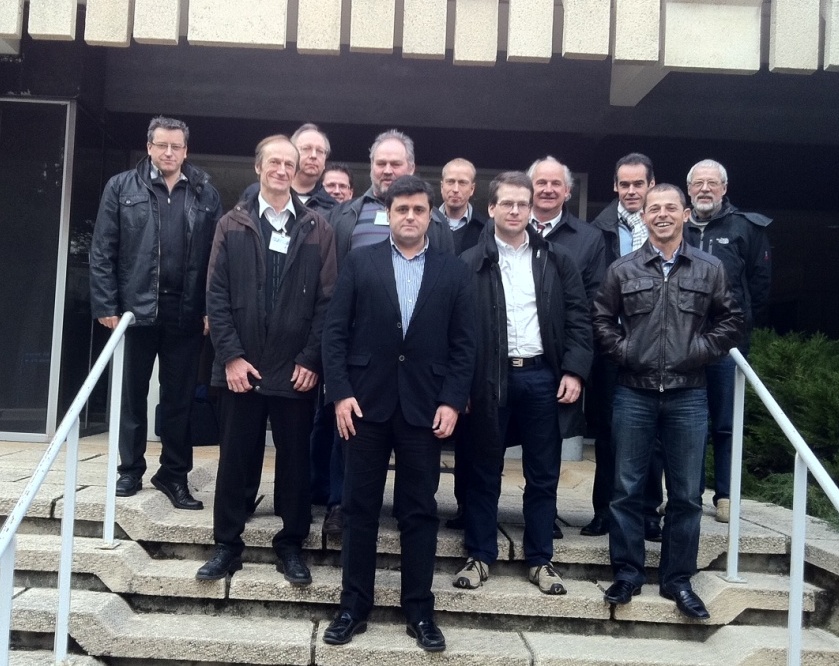Specialist Task Force 418:
DECT maintenance and NG-DECT development 2011
Who we are:
Team Leader: Angel Boveda angel.boveda@wirelesspartners.es

What we do:
DECT (Digital Enhanced Cordless
Telecommunications) is
one of the very successful ETSI standards. With more than 800 million DECT
devices in the market, DECT is the worldwide leading technology for cordless
telephony on both, residential and business (PABX) scenarios.
DECT is one of the IMT-2000
technologies and has a worldwide market (including the U.S.).
ETSI TC DECT and STF 418 are
currently developing the release 2011 of the DECT standard and the new
specifications as part of the New Generation DECT
program, a further
evolution of the standard, introducing new advanced features such as High
quality wideband (7 kHz) and super wideband (14 kHz) voice, support of internet
telephony, and broadband data connections.
DECT New Generation is based
on the mature and reliable DECT technology and will be back-compatible with
current DECT devices.
The scope of STF 418 consists
of the following parts:
A) Enhancing the security
features for DECT (authentication and encryption) to the current state of art,
including the addition of new algorithms based on AES.
B) General maintenance of the
DECT base standard, EN 300 175 parts 1 to 8, as result of industry feedback,
test feedback, security considerations and NG-DECT development.
C) General maintenance of the
Generic Access Profile EN 300 444 (GAP) as result of industry feedback, test
feedback, enhanced security and interaction with NG-DECT development.
D) New release of the New
Generation DECT; part 1: wideband speech (TS 102 527-1) as part of the NG-DECT
development program.
E) New release of the New
Generation DECT; part 3: extended wideband speech services (TS 102 527-3) as
part of the NG-DECT development program.
F) Production of the new
specification New Generation DECT; part 5: additional feature set for extended
wideband speech services (TS 102 527-5). This specification will define a new
set of products with expanded capabilities compared to previous releases and
corresponding to what DECT Forum calls CAT-iq 2.1
The requirements for this
release have been provided by DECT Forum, and have been coordinated with HGI
(Home Gateway Initiative), since it is believed that it will be implemented
embedded in home gateways/ADSL routers in a similar way to WIFI radios today.
Examples of the new
requirements are: improved phone book handling, additional VoIP functions and
enhanced SIP/H.323 connectivity, answering machine control, SMSs, new handset
capabilities, security enhancements and green ECO mode.
The STF
outcome will be materialized in the short term on real products that will be
sold in large scale, and that will provide tangible practical benefits to the
end users.
Why we do it:
DECT is one of the most
important ETSI standards in terms of public acceptance. The standard provides a
convenient solution to the needs of cordless telecommunications in the business,
residential and WLL scenarios. DECT dominates the voice cordless market with an
installed base of 800 M of devices.
The work on DECT New Generation
has attracted new ETSI members. It is also related to the ETSI Green Agenda.
The DECT manufacturers
including the chip manufacturers have come to the conclusion that the evolution
in Internet and Telecom areas creates the opportunity for a new generation
Cordless standard, taking full advantage of the convergence Internet/Telecom.
In addition to that, the maintenance of the base standard and Generic Access
Profile is needed due to the addition of new features as result of the work on
DECT New Generation, and because of feedback from the industry and product
testing activities. All these specifications are continuously used by the
industry in a wide range of products.
The new generation DECT will
not only further increase the technical performance, but also the value of the
DECT products.
For more details, see our
Terms of Reference
Time plan for the work:
Start of the work: January 2011
Target date for end of the work: December 2011
How to contact us:
If
you would like more information, please contact the STF Leader:
Angel Bóveda
angel.boveda@wirelesspartners.es
This information is based upon STF working assumptions.
The views expressed do not necessarily represent the position of ETSI in this
context.
Last updated: 2013-04-13 17:33:49